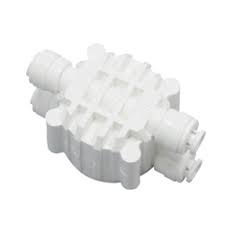BuckleyBrew
Member
- Joined
- Nov 22, 2017
- Messages
- 8
- Reaction score
- 0
I recently purchased a used RO system that includes 3 pre-filters (I believe they are sediment, GAC, and ??), an RO membrane, and a final "polishing" filter. I don't know how long it was in previously use or when the filters were last changed, but for $20, I couldn't pass it up.
When I installed the system, I bypassed the pressure tank using the logic that I'll only be slowly filling my HLT with RO water over multiple hours prior to brewing and I don't need to have RO water on demand at a high flow rate.
I tested the system last night and noted the following:
- The RO water flow rate was extremely slow, like ~1 drop/sec, compared to the wastewater flow rate, which I didn't measure but would estimate was around 0.5 liter/min.
- TDS of the RO water was around 155 ppm; TDS of the source water (municipal) was around 190 ppm. I verified the accuracy of the TDS meter using bottled DI water, which registered 0.0 ppm.
Obviously the RO system isn't doing its job. Questions for RO system users:
1. What steps should I take to improve the rejection %?
2. What is the normal RO/wastewater flowrate I should expect?
3. Could bypassing the pressure tank contribute to the low rejection % and/or low RO flow rate?
Thanks!
When I installed the system, I bypassed the pressure tank using the logic that I'll only be slowly filling my HLT with RO water over multiple hours prior to brewing and I don't need to have RO water on demand at a high flow rate.
I tested the system last night and noted the following:
- The RO water flow rate was extremely slow, like ~1 drop/sec, compared to the wastewater flow rate, which I didn't measure but would estimate was around 0.5 liter/min.
- TDS of the RO water was around 155 ppm; TDS of the source water (municipal) was around 190 ppm. I verified the accuracy of the TDS meter using bottled DI water, which registered 0.0 ppm.
Obviously the RO system isn't doing its job. Questions for RO system users:
1. What steps should I take to improve the rejection %?
2. What is the normal RO/wastewater flowrate I should expect?
3. Could bypassing the pressure tank contribute to the low rejection % and/or low RO flow rate?
Thanks!







































![Craft A Brew - Safale BE-256 Yeast - Fermentis - Belgian Ale Dry Yeast - For Belgian & Strong Ales - Ingredients for Home Brewing - Beer Making Supplies - [3 Pack]](https://m.media-amazon.com/images/I/51bcKEwQmWL._SL500_.jpg)


















